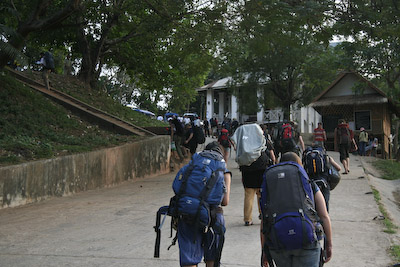New cultural tourism site to open soon in Laos
 Photo: Monks observe the scenery during sunset at Vat Phou Ngoy temple in Champassak province.
Photo: Monks observe the scenery during sunset at Vat Phou Ngoy temple in Champassak province. In Champassak province there are lots of attractive tourist sites including Vat Phou, Khon Phapheng, Tad Fan and Pha Suam waterfalls; apart from these places there are also other mysterious sites that are less well known such as Vat Phou Ngoy.
Only local people know about this temple, which has a relaxing atmosphere and views of the Mekong River and islands.
The temple is included in some package tours, which suggest visitors “spend the night at Vat Phou Ngoy and enjoy the wonderful panoramic views of the sunset over the Mekong.” These tours help promote the temple which sits in the shadow of more popular tourists sites in the province...more
Vat Phou Ngoy is located on Malong hill in the area of Pakhor village, Champassak district. Monk Bounmak Thitipannyo, the temple's first abbot, founded it in the 1930s.
An official at the Champassak Tourism Information Centre, Mr Phonesavanh Chanthalangsy said, “There are lots of attractive sites at this temple. Visitors can walk to the south of the temple where they can enjoy the wonderful panorama of the islands located in the Mekong River. Local people call it the second Si Phan Don (4,000 Islands). It is a place where visitors can relax, especially at sunset during the dry season.”
This viewing point is particularly popular with visitors who love photography because they can capture the natural scenes of the river and the lifestyle of people fishing and working along the bank of the river, which reflects the importance of the Mekong in the way of life of people in the area.
“Walking to the south-west of the temple, visitors can find three mysterious large holes in the ground that are similar to wells,” said Mr Phonesavanh. “They are different sizes, the biggest one has a radius of 40cm and is 85cm deep, the second one is 30cm across and 70cm deep while the smallest one has a radius of 20cm and is 60cm deep.”
Mr Phonesavanh said the elders in the village tell of the temple's very long history and a local legend which says, that before the temple was built, on every full moon a magical light flowed through the air and disappeared into the three holes. The mysterious incident has not happened since the temple was built.
Every full moon in February there is an annual festival at Vat Phou Ngoy and people from around the country flock to the temple to celebrate and give offerings.
Another special element of the temple is its seven cloisters that are made from wood instead of the usual concrete.
For visitors who come during the rainy season, the views of the Mekong are not as spectacular as in the dry season, but they have the chance to see other attractions and a wonderful waterfall located to the west of the temple.
Originally, the path to the temple was made of natural stones collected nearby, but renovations in 2004 saw the stones replaced with concrete and there are now 834 steps climbing the 90m to the top.
With construction underway on a new road that will make it easier for tourist to access the temple, the Champassak Tourism Office, together with provincial and district authorities, is preparing to develop the temple into a natural and cultural tourism site to cater for an increase in visitors which will come once the road has been completed.
Vientianetimes
Đăng ký:
Đăng Nhận xét
(
Atom
)










Không có nhận xét nào :
Đăng nhận xét